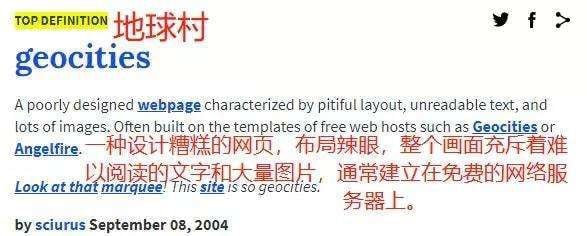This article comes from the public brain (ID: unity007), author I am a panda, love fan The child is authorized to publish.
When you mention the early Internet, what do you think of?
Windows 98, dial-up, web pages that can only be loaded in a few minutes, and shoddy GIFs… But all these memories have once returned to our lives in the art of steam waves. Girls take selfies with the borders of Windows Paint software, and neon-toned pixel drawings appear in every corner of the Internet.
But outside these “artworks,” the real early Internet is disappearing a little bit.
When we sent out the first email, the medium for storing the information was a little bit from the stone tablet to the hard disk and the server. Although there is little promise, we subconsciously believe that information stored on the Internet will never disappear.
But the case of GEOcities gives people a good lesson.
Valued $4.7 billion in Internet New World
In the 1990s, the price of servers was very expensive, and most of the time it existed as a corporate service. People think that it is almost a fantasy to make their own day’s complicated trivia into text, pictures, audio and video uploading to the Internet.
But in 1994, a website called Beverly Hills Internet was born and began to provide users with free services to build a website homepage. Although the maximum capacity of each page at that time was only 2MB, it was not as good as today’s photo, but it still attracted a lot of people to participate. Later, the name of Beverly Hills Internet was changed to GEOcities, the global village that connects people all over the world.
In the 1990s, the Internet was like a piece of new land that had not yet been developed. Although it has not yet been exploited for its effective use, people want to compete to leave their mark on this continent.
The GEOCities became the most free-form website, some people discuss military here, some people record diaries here, others make e-cards to bless friends and family, but more often leave a photo and a name to come Prove that you are on the Internet.

Before the once-popular personal blog MySpace, GEOcities is going to be ten years earlier. With the popularity of the Internet, there are more and more users on GEOcities. In 1997 alone, GEOcities had 1 million users, equivalent to 7% of the total Internet users at the time. No income for the next year GEOcities is listed on the Nasdaq, and the price of $17 per share has doubled in 24 hours.
But soon with the bursting of the .com bubble, GEOcities, which have been unable to earn revenue, are also looking for a retreat. Of course, this retreat is also bright. In 1999, Internet overlord Yahoo acquired GEOcities for $4.7 billion. .
Data junk, and data heritage
After the acquisition, Yahoo wanted to launch payment services to users, but because the online payment path was not smooth, the number of websites offering free services increased, and Yahoo’s charging route was not smooth.
There is no income, and it bears a huge server burden. At the same time, after entering 2000, Yahoo, a more complete and socialized personal blogging business, soon wanted to sell GEOcities, but it was hard to take over. Yahoo was finally preparing to close GEOcities in 2009. During this decade, GEOcities turned around. Transferred from the United States to Japan, and eventually ended most of the business.
The closure of GEOCities means that the homepages of these users, including all pictures, text, and audio, will completely disappear from the world. This is also the first time in the history of human Internet that such a large-scale realization that the information that it has left on the Internet is so vulnerable.

In order to protect these data, the civil society began to appear a lot of spontaneous organizations, they are programmers, some are UI designers, and some are university web design course instructors. These people didn’t try to convince Yahoo to keep the business, but they copied the pages to Tumblr a little bit. In the process, the volunteers found that many of these pages were not visited for more than a decade. The owner has passed away. These pages are both “data waste” and “data heritage.”
The Internet has disappeared in development
The reason why volunteers protect these pages actually tells us, what value does the Internet of the ancient times have in the creation of unlimited value in the mobile Internet?
The first thing that touched the volunteers was the artistic value contained in these pages.
Click on the page today and what do we see? Undoubtedly a minimalist design, the waterfall shows a sharp and clear picture. In fact, whether it is a PC web page or a mobile app, the aesthetics of Internet interaction design is infinitely converging. Everything is designed to make way for the most convenient information display, short video products vibrating, image social products Instagram, text social products Twitter.
But time went back to 2000, when the web design was more rich in aesthetics. Even though web page capacity and performance are limited, people have created cosmic stars, 360° promotional kitten GIFs, and colorful e-cards. The preservation of all this is not just for “retro”, but to remind everyone that the web design used to be so diverse and creative.

At the same time, these pages have a natural historical value.
As the Internet becomes more connected to human life, data on the Internet is also documenting the footprints of human action. Recently, there is a popular word called “electronic patina”, which means that an expression pack is blurred because of repeated transmission and preservation. Although it is a joke, it also means that the Internet is becoming more and more ancient and begins to distinguish between the epoch. At this time, a web page established by ordinary people in 2000 was preserved. For the human society hundreds of years later, it is like today that a civilian tableware of the Tang and Song Dynasties was excavated. It is of great significance for studying the history of the Internet and the situation of human life in a certain era.
Finally, the volunteers also want to evoke people’s attention to the “evaporation” of the Internet.
It’s not a single case that happened to GEOcities. Before GEOcites, there were already a lot of early webpages that couldn’t afford the server cost, and let it be 404. The wisdom creation or emotional aura that people once left on these pages has also gone with the wind. Even this situation does not only appear in early Internet pages, even today.
March 2019, once BoMyspace owner Myspace claims to have lost all photos, videos and audio files uploaded before 2016 due to server migration errors. In May of the same year, Baidu Post Bar said that due to data maintenance, posts before 2017 will be temporarily unavailable.

The fact is that in the 1970s, when you bought a notebook, even if the production line was shut down or even the business went bankrupt, the things you recorded in your notebook would still belong to you forever. But in the Internet age, perhaps only a small operational error, the information about you will disappear.
Volunteers hope to protect GEOcities by calling on Internet companies to focus on user data—not just protecting private data such as user credit card security codes, email addresses, but also users’ creation on the platform.
Of course, as the user itself, these situations should also be taken seriously. The data you left on the Internet is a sign of your important existence.